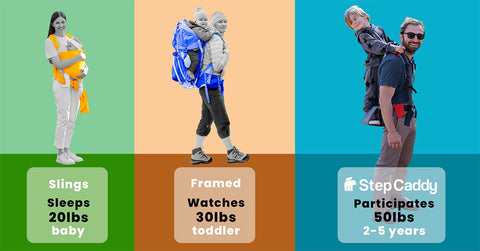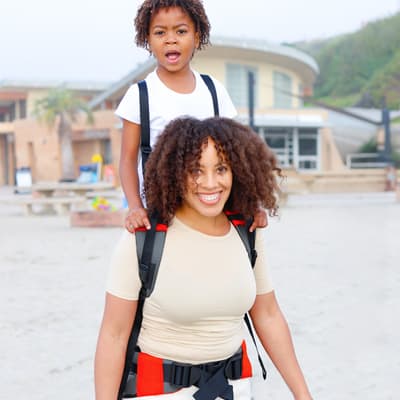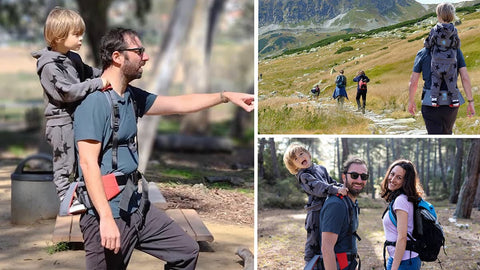

Child Carriers for 5 Year Olds
The quick answer is yes. But there are a few that are excellent and specifically designed for the unique needs of a 4-year-old or 5-year-old. Most child carriers for bigger kids are simply larger versions of toddler carriers and have not taken into account the very different needs and physics of a heavier, larger child.
When it comes to carrying your 5-year-old child safely while keeping comfort and mobility in mind, choosing the right carrier is essential. Parents want a solution that minimizes strain, supports their child’s posture, and ensures comfort throughout any activity. Step Caddy offers a cutting-edge solution that redefines child carriers with its weightless carrying experience, ergonomic design, and advanced materials tailored for preschool-aged children. In this article, we explore the importance of selecting an appropriate carrier, examine different types available, provide safety tips, guide you to reliable retailers, discuss budgeting for quality, and share recommendations from other parents.
At some point, every parent of a preschooler faces that tired little voice mid-hike or mid-theme park, "Carry me!". Welcome to the preschooler paradox: your child is too big for most carriers, too young for long distances, and too independent for cumbersome strollers. But the average 5-year-old boy weighs 40+ lbs (18 kg)! Carrying this much weight without the right tools leads to back pain, shoulder aches, and will quickly tire you out. No wonder parents tend to dread carrying, avoid carrying, experience stress, weather tantrums, and even postpone longer days out.
This doesn't have to be the case, with the right carrier. However, when your child is a baby, you have thousands of carriers to choose from. As a toddler, you have hundreds of options. When your child reaches preschool age (3, 4, and 5), preschool carrier options dwindle to half a dozen.
So, what now?
Let's talk strategy. Specifically, how to carry your 5-year-old in a way that's safe, comfortable, and keeps your spine intact. We'll break down the best child carrier options and why your decision matters more than ever at this age.
The Differences of Carrying a 5-Year-Old
Size
A 5-year-old is markedly longer than a toddler, with a taller torso, longer legs, and greater overall limb length, which dramatically changes how they fit in a child carrier. Many carriers based on toddler designs force the older child into a cramped, uncomfortable seated position, with knees bent too tightly, legs and feet left dangling awkwardly, and arms searching for a place to rest. The added height of a 5-year-old means their upper body extends farther up the parent’s back, potentially interfering with movement and balance, knocking heads, while their longer legs can bump against the parent’s thighs. For true comfort and ergonomic support, a carrier for a 5-year-old must rethink the right type of accommodation - otherwise, both the child and the parent are in for an uncomfortable ride.
Weight
The weight difference between a toddler and a 5-year-old isn’t just a number on a scale; it’s a game-changer for your spine. Toddlers typically weigh 20–30 pounds, a load that many soft-structured or sling-style carriers can handle (albeit with some shoulder fatigue). But a 5-year-old can easily top 50 pounds, and that kind of weight, especially when perched high on your back, becomes a biomechanical liability. Without a well-designed system that transfers weight properly, you’re left carrying the equivalent of a sack of cement. That’s where a properly engineered load-bearing waistbelt becomes essential. It shifts the load to your hips - your body’s natural powerhouse, turning a grueling carry into a manageable, even comfortable, fun experience.But not all waist belts are created equal. The waistbelt is only as effective as the system that feeds weight into it. The point at which your child's weight attaches to you is the Weight Transfer Point. Ideally, this would be at your hips: the strongest Avenger, but it is usually higher up your back and, in some cases, even your shoulders. You need a system that takes the weight from the child's 'center of mass' to a 'weight transfer point' that should be on your hips. The key is not just having a waistbelt, but ensuring the weight transfer point is low and aligned with your body’s center of gravity. When a child’s weight is anchored too high, common in traditional carriers that favor seated positions, it destabilizes your balance and forces your muscles in your lower back into overdrive to compensate. Carriers designed for preschoolers, like Step Caddy, lower the weight transfer point and use your hips as the base of support, keeping you upright, mobile, balanced, and pain-free. It’s not just about comfort, it’s about protecting your back from chronic pain, reducing fatigue, and allowing you to go farther without paying the price in chiropractor visits. When your child crosses that 40-pound threshold, an ergonomic carrier with true hip support isn’t optional. It’s survival gear.To learn more about this, visit: How Waist Belts in Toddler Carriers Save Your Spine (and Your Sanity)
Usage Pattern
Toddlers and 5-year-olds use child carriers in very different ways, and understanding that difference is key to choosing the right design. A toddler tends to be a passive passenger, agreeable to sit high and cozy in a big-framedcarrier, observing the world from their padded perch for long periods of time. These traditional carriers cater to long, continuous carrying, where the child is seated for extended periods. In contrast, a 5-year-old is far more active and independent. They’ll run, jump, explore, and only ask for a lift when their legs finally give out, usually halfway through a hike, at the bottom of a big hill, or just at the end of a long day. That’s why, for preschoolers, the carrier must support intermittent use with minimal friction. A design that allows quick, independent mounting and dismounting is essential. If it’s a hassle to get your child in and out, you’re more likely to skip the carrier altogether and put up with the tantrum. Ease of access isn’t a luxury at this stage; it’s the difference between a smooth outing and a stress-inducing meltdown.To learn more about this, visit: Solving the Child Carrier Paradox
Conclusion
A decent child carrier for a 5-year-old will be a radically different design from that for a toddler. You need a child carrier that is rated for 50 lbs! Luckily for you, there are only four that we found.
Choosing a Carrier for 5 Year Olds
Thus, choosing the right hiking carrier for a 4-year-old is crucial. It ensures a pleasant experience for everyone involved. It can remove stress, hassle, tantrums, and back pain, and can extend a great day out. The right carrier can make all the difference. You are looking for a preschool carrier, or maybe a hiking carrier that:
- Transfers weight effectively to your hips - away from your back. Look for carriers with intentional weight transfer solutions. Look at the back posture needed when carrying - ensure the back is straight, the parent is balanced and mobile.
- Large sizes to accommodate a bigger kid - look where the legs and especially the feet go.
- Ease of use - The carrier must be quick and hassle-free to climb on and off. The easier and more seamless it is for your child to go from walking to riding, and back to walking again, the more you will use the carrier.
- Supports Engagement - Preschool-aged kids are fully engaged and participate. Their legs may be tired, but that does not mean they want to stop interacting; don't miss out on the opportunity for amazing shared experiences and conversations.
- Packs Up Small - Optional. If you are travelling or would prefer not to wear the child carrier all day, when it is not in use, look for a hiking carrier that can pack away into your day-bag, backpack, or carry-on. This is usually the winning feature of soft-structured carriers.
These Are the Top Hiking Carriers for 5 Year Olds
Below are the top hiking carriers that work for 4-year-olds. But one must still check the manufacturer's specifications carefully. For example, the Deuter Kid Comfort 3 Child Carrier specification states the maximum weight is 48.5 pounds, which at first look would comfortably accommodate your 4-year-old. But this weight specification includes the weight of the child, any gear, any snacks, and the pack. Your 5-year-old is likely close to 40 lbs already, so read and understand the manufacturer's specifications and consider how long the carrier will last you.
Below we look at:
- Deuter Kid Comfort 3: All-day hikes; travel; larger preschoolers. Adjustable, great ventilation/storage. supreme comfort.
- Osprey Poco Premium: All-day hikes; travel; larger preschoolers Adjustable, great ventilation/storage.
- My Freeloader: Designed for children 2.5 years or older with a carrying capacity of up to 80 lbs!
- Piggyback Rider Scout: Short hikes or mixed walking and riding Light weight, great ventilation, child can walk/riding mix, fun.
- The Step Caddy: All-day hikes; travel; larger preschoolers Adjustable, great ventilation, child can walk/riding mix, fun, innovative design.
1. Deuter Kid Comfort 3
Big framed carriers are the limousines of toddler carriers. They transfer weight to the hips really well through the frame. The main concerns for using with a 4-year-old is does the kid still fit comfortably in the seat, and that the child will want to get in and out, which is a big hassle. When the kid is not in the carrier you are lugging around 8'lbs of carrier on your back, it is not something you can just stow away when it's not in use.
- Ages: Up to 48 lbs (inc stowed items)
- Price: $350
- Pros:
# Weight distribution is excellent with an internal frame that channels the child's weight to a load-bearing waistbelt.
# The carrier is bulky, but ventilation is good, utilizing mesh panels around the frame to keep the wearer's back aired.
# Additional storage is excellent, with compartments for snacks and gear.
# Comfort is excellent, should be based on the name, achieved with heavily padded and adjustable straps, waistbelt, and seating for the child - Cons:
# It is bulky and heavy (~7 lbs 11oz), making portability very poor. It will consume half your car trunk space. You do not need to pack it away, because you will have to wear it all day.
# Getting in and out is involved and time-consuming.
# Balance & Mobility is concerning for a heavy 4-year-old, the sitting weight is high up the torso, and the child's center of mass is a good 12" behind the adult which will have an impact on balance and stability.
# Ergonomics for a 4 year old is medium to poor. The child is cramped in the chair.

2. Osprey Poco Premium
Osprey Poco Premium gives lots of storage, convenient extras like sunshade and day-pack. Great for parents who carry a lot of gear.
Big framed carriers transfer weight to the hips really well through the frame. The main concerns for using with a 4-year-old is does the kid still fit comfortably in the seat, and that the child will want to get in and out frequently, which is a big hassle. When the kid is not in the carrier you are lugging around 8'lbs of carrier on your back, it is not something you can just stow away when it's not in use.
- Ages: Up to 48 lbs (inc stowed items)
- Price: $420
- Pros:
# Weight distribution is excellent with an internal frame that channels the child's weight to a load-bearing waistbelt.
# The back panel uses a continuous mesh fabric wrapped around the metal frame, so the pack is slightly suspended off your back for ventilation.
# There are pockets galore. 11 pockets and a whopping 36 liters total of volume.
# Comfort is excellent, achieved with heavily padded and adjustable straps, waistbelt.
# Comes with a sunshade - Cons:
# It is bulky and heavy (~8 lbs 5.4 oz), (heavier than the Deuter) making portability very poor. It will consume half your car trunk space.
# Getting in and out is involved and time-consuming.
# Balance & Mobility is concerning for a heavy 4-year-old, the sitting weight is high up the torso, and the child's center of mass is a good 12" behind the adult which will have an impact on balance and stability.
# Ergonomics for a 4 year old is medium to poor. The child is cramped in the chair. The stirrups help with the dangling feet.

3. My Freeloader
- Ages: Up to 80 lbs
- Price: $320
- Pros:
# Weight distribution is good with an internal solid structure that distributes the child's weight evenly across the harness and load-bearing waistbelt.
# Reasonably light at 5.8 lbs. Folds in half to reduce its size.
# Comes in two sizes for adults with larger torsos.
# Good low center of mass, that is close to the adult's center of mass, for good balance and mobility.
# Ergonomically good for a 4-year-old. The child sits lower than the Deuter or Osprey, so they may be staring at your back. - Cons:
# Not super light, and does not fold up that small. Still better than many carriers like the Osprey or Deuter.
# Weight distribution is good, but could be better. Reviewers reported a sore back after 45 minutes of carrying, probably due to the inclination to lean forward when carrying.
# Additional storage pockets on the belt side are minimal compared to other carriers.
# Loading the child can be difficult. Reviewers commented that the process typically requires lifting the child into position and securing the harness behind you: “It’s a bit of a two-person job"
# Comfort for the child that is straddling a bench is limited - but good for shorter journeys. The child's legs tend to wrap around the adult and ache.
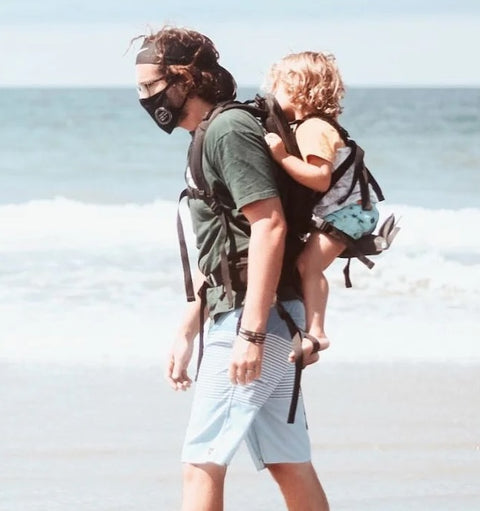
3. Piggyback Rider Scout
A smart simple child carrier that provides a standing platform (a bar), allowing children more freedom and a fun vantage point. Has very easy on-off ease-of-use, and tons of customer reviews extolling the convenience. For a 4-year-old use, the fact the weight is ALL carried on the shoulders with no weight transference to the hips is a concern for back comfort and balance on uneven ground. Packs up small, is light and is great for travel for those reasons.
- Ages: Up to 50 lbs
- Price: $150 (plus accessories)
- Pros:
# Very lightweight and packs up small. Great for packing away and taking on your day out or travels.
# Good balance and mobility. The child in a standing position places their center of mass really close to that of the adult's.
# No storage on the carrier - BUT since it is lightweight and very portable, it gets packed into a backpack, which will carry your other items.
# Comfort is good. The carrier gets great reviews for comfort, the only concern is long term comfort with all the weight going to the adult's shoulders.
# Very easy to use, with quick and easy mounting and dismounting, no additional adult assistance required.
# Ergonomically fantastic for a 4-year-old. No cramped conditions, great vista view to stay connected with the parent for shared experiences. - Cons:
# Weight distribution is poor, ALL the weight going directly to the shoulders and back of the adult.
# The child stands on a bar, there is nothing securing the feet from slipping.
# Tips of the feet and the bar, poke into the adult's back, unless the child stands with their feet far apart to go either side of the adult's back.
# Muddy feet on the bar will dirty the adult's cloths. (There is an accessory "skirt" that addresses this)
# The child is standing, so no option for sleeping if that is needed.
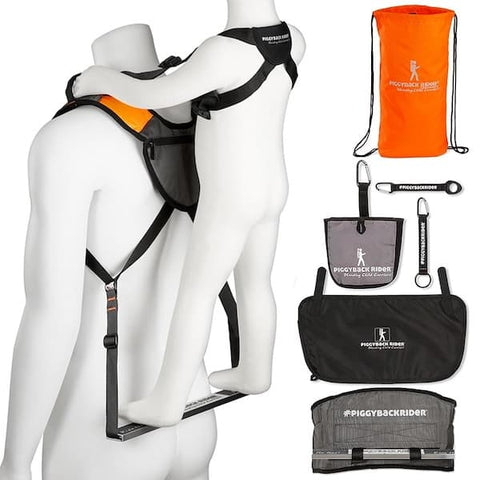
4. The Step Caddy Carrier
Step Caddy is a unique innovation that reimagines the piggyback ride into a safe, comfortable, and portable experience perfect for hiking and adventures with preschoolers. It combines comfort, versatility, and convenience into a balanced, backpack-like design. it provides a standing platform, allowing children more freedom and a fun vantage point, while significantly reducing the strain on parents.
- Ages:
2 -5 years old (50 lbs) - Price:
$195 - Pros:
# Saves Your Back: Weight distribution is unmatched. Step Caddy uses a special, patented load-bearing waistbelt that transfers allt he kids weight directly to the hips.
# Balance and Mobility is excellent, with a low center-of-mass, an even lower weight transfer point at the hips the adult's balance and mobility is maximized, even on rough terrain.
# Exceptional Ease-of-Use: The piggyback standing position creates the easiest carrier to climb-on and climb-off. Additionally, because the child's weight is all on the hips and not the torso, this makes standing up from the loading crouch much easier.
# Packs Up Small: small. Small enough to throw into your bag, trunk, or carry-on. - Cons:
Only hydration accessories options available at this time. The child is standing, so no option for sleeping if that is needed.

Comparison Summary
Age / Weight | Weight Transfer | Balance & mobility | Ergonomic Design for 4-Year-Old | Storage & Pockets | Ease of Use | Packs Up Small | |
Deuter Kid Comfort 3 | 4-year-old < 48lbs | Excellent | Good | Moderate | Good | Poor | Poor |
Osprey Poco Premium | 4-year-old < 48 lbs | Excellent | Good | Moderate | Excellent | Poor | Poor |
My Freeloader | < 80 lbs! | Moderate | Excellent | Moderate | Moderate | Moderate | Moderate |
Piggyback Rider Scout | 5-year-old < 50 lbs | Poor | Moderate | Excellent | Not Applicable | Excellent | Excellent |
Step Caddy | 5-year-old < 50 lbs | Excellent | Excellent | Excellent | Not Applicable Hydration Holders | Excellent | Excellent |
How to Choose the Right Hiking Carrier for Your Family
Selecting the right hiking carrier for your family involves various considerations. The first aspect is comfort for both the parent and the child. A carrier with adjustable straps and ample padding ensures a snug fit. Next, consider your hiking habits and environments. Consider all the other potential uses and situations you will want to use the carrier - are you going traveling, to theme parks, or a festival?
Child Carriers are expensive; pick one that will accommodate all your needs.
Finally, think about additional features that we identified as important for a Carrier for a 5-Year-Old:
- Transfers Weight to your hips
Click Here: Interesting article on protecting the spine - Ergonomic for larger kids
- Ease of use
Click Here: Interesting article on Piggyback Carriers - Packs Up Small
Frequently asked questions
A: From day one, Step Caddy was designed with a singular goal: to eliminate back strain while carrying older kids. While many carriers claim comfort, most still place the child's weight high on your torso, forcing your spine to compensate and your posture to suffer.
Step Caddy takes a smarter approach, positioning your child in a natural standing "piggyback" stance and anchoring theirweightthrough integrated stirrups in the waistbelt. This creates a class-leading low load-transfer-point shifting all the child'sweightdirectly to your hips, resulting in a remarkably weightless carrying experience. It frees your back of strain, improves your posture, and gives you greater balance and mobility on any terrain.To learn more about this, visit:How Waist Belts in Toddler Carriers Save Your Spine (and Your Sanity)
When choosing a childcarrier, prioritize safety features that protect both your child and your posture. Look for a secure harness system that keeps your child firmly in place, preferably with magnetic or locking buckles forquickand foolproof fastening. A well-designed waistbelt is essential, it should transferweightto your hips and include padding for comfort and stability. Check for a low center of gravity and aweighttransfer point close to your body to enhance balance.Footstirrups help prevent slipping and stabilize your child’s stance, especially in piggyback-stylecarriers. Additional safety touches like reflective strips, breathable materials, and durable, reinforced stitching round out a smart,trail-ready design.
Asafety harnessfor the child towearthat easily attaches to the Yolk around theparent's shoulders. Built-inStirrups are built into the load-bearing waistbelt. These secure the feet, prevent unplanned dismounting due to slips, keep dirty shoes away from parents' clothes, and allow the child to relax because their footing is assured. The stirrups grip the feet during transits and relax and cleverly release the feet when dismounting.Step Caddy uses magneticself-locking buckles, so theparentonly needs to bring the buckles close to one another for them to attach. The buckles then automatically lock, ensuring the child's safety.Step Caddy harness attachment position is at chest level, forward of the shoulders so theparentcan see buckles with ease without craning theirneck(mostcarriersput the buckles uncomfortably on the shoulders, behind the natural line of sight)Web Tunnelsthread the harness straps under the grip handles. This protects the hands of the smaller riders.
No, it is not safe. You should always be cognisant of the manufacturer's size andweightrecommendations, as the products have been tested to these weights.It is best to choosecarriersspecifically designed for older children to ensure properweight distributionand structural support tailored to a preschooler's growing body.
Not always, but higher-priced models like the Step Caddy often incorporate advanced materials, technology, and designs that provide better long-term durability and support.
A high-quality childbackpackcarrieroffers long-term benefits that go beyond comfort on a single hike;carrierslike Step Caddy protect your posture, reduce strain on your spine, and prevent chronic back andshoulderissues as your child grows. Properly distributingweightto your hips and maintaining a low center of gravity enables longer outings without fatigue, enhances your balance on uneven terrain, and promotes healthy carrying habits. Over time, this means more adventures, lesspain, and better physical well-being for parents who want to stay active with their kids..
Most hiking carriers are suitable for children aged six months up to four years. Age, however, depends on the child's weight and carrier specifications.
The carrier must distribute weight evenly. Adjust straps for both comfort and safety. Ensure your child is snugly seated, with no excessive movement.
Yes, they are safe if used correctly. Choose carriers with certifications and safety features like a five-point harness. Regularly check for product recalls.
Absolutely! These carriers are versatile. Use them for travel, city tours, or even beach outings. They adapt to various environments and activities.
Regular cleaning and inspection are essential. Check for damage after every hike. Follow the manufacturer's guidelines for specific maintenance requirements.

